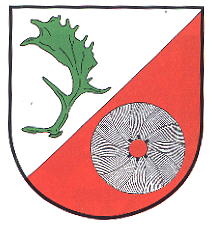Damsdorf: Difference between revisions
Jump to navigation
Jump to search
Knorrepoes (talk | contribs) No edit summary |
Knorrepoes (talk | contribs) m (Text replace - "[[Literature" to "{{media}} [[Literature") |
||
| Line 22: | Line 22: | ||
The two main colours in the arms are taken from the old colours of Holstein. The antler in the upper part is from a fallow deer (Damwild) and thus canting. It also symbolises the rich nature in the area. The millstone symbolises the (former) windmills in the area. | The two main colours in the arms are taken from the old colours of Holstein. The antler in the upper part is from a fallow deer (Damwild) and thus canting. It also symbolises the rich nature in the area. The millstone symbolises the (former) windmills in the area. | ||
{{media}} | |||
[[Literature]] : Peters, 1974 | [[Literature]] : Peters, 1974 | ||
Revision as of 20:26, 8 July 2014
| Heraldry of the World Civic heraldry of Germany - Deutsche Wappen (Gemeindewappen/Kreiswappen) |
DAMSDORF
State : Schleswig-Holstein
District (Kreis) : Segeberg
Amt : Amt Bornhöved
Official blazon
Von Silber und Rot schräglinks geteilt. Vorn eine aufrechte grüne Damwildschaufel, hinten ein silberner Mühlstein.
Origin/meaning
The arms were officially granted on June 3, 1992.
The two main colours in the arms are taken from the old colours of Holstein. The antler in the upper part is from a fallow deer (Damwild) and thus canting. It also symbolises the rich nature in the area. The millstone symbolises the (former) windmills in the area.
Contact and Support
Partners:
Your logo here ?
Contact us
© since 1995, Heraldry of the World, Ralf Hartemink 
Index of the site
Literature : Peters, 1974











